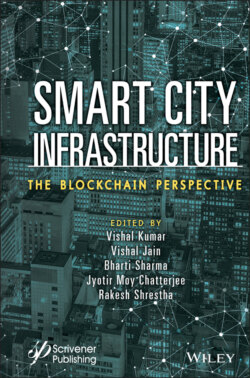Читать книгу Smart City Infrastructure - Группа авторов - Страница 35
1.5 Internet of Things and Blockchain 1.5.1 Internet of Things
ОглавлениеThe invention of the IoT impacts promotes our daily life than ever before. In the coming years, kitchen applications, utility materials, thermostats, televisions, cars, smart phones, intra-body sensors, and approximately everything connects with the internet then reachable from anytime, anywhere on the globe. The rising ease that IoT brought to the 19th century is unmatchable and uncomparable. Moreover, it continuously improvising every human segment, manufacturing starts from healthcare, smart home, e-healthcare, along with smart city to surveillance, data mining, intelligent transport, and manufacturing [6–8]. Scientists and researchers highly focused on addressing IoTs computation and communication scalability concerns from the past few years. Undoubtedly these two concerns are most important for the success of IoTs and should carefully explore. Both IoT safety and confidentiality are vital research actions to be conquered [10–16].
Up-to-date IoT systems are implemented with a central-based architecture and client-server-based access model. IoT dealings like data, documents, and instructions among IoT entities assigned to monumental, federal service providers. However, eventually, IoT is vulnerable to various privacy as well as security problems. In particular, federal and centralized service providers use IoT data intelligently; some of the centralized data gathering systems can rendering the method of hacking by malevolent activities, with awful consequences for citizens [18–28]. One more dispute is the authentication of IoT units, which is mostly employed naturally with limited supervision. If these issues not appropriately answered, there was a chance to create hard active and passive attacks.
The amalgamation of blockchain along with IoT has disruptive potential and assists the IoT’s development into our culture through providing subsequent essential rewards:
1 i. Anonymity: An IoT entity with the inclusion of blockchain with various secure keys, but it does not expose entities real characteristics and individuality.
2 ii. Decentralization: Long-established centralized methods need each operation must be legalized from end to end with a centralized model, which unavoidably transforms into a performance block. In opposition, third-party confirmation is not required in the blockchain because consensus processes preserve data reliability.
3 iii. Non-repudiation: It guarantees that the dealings can be authorized then illogical dealings not confessed—it is almost intolerable to remove any transactions once integrated into the blockchain.
While the blockchain might appear as per a solution to the IoT’s safety as well as privacy problems, but still numerous researches detect various challenges while employing IoT into the real-world. Greatest part of the research works states blockchain as an undeniable, incontestable data composition from literature. Still, it is theoretically unfocused to describe it as indisputable or not able to be forfeited. If truth be told, then there are patterns where the blockchain entries have been altering after attacks or misconduct of the system/network. As mentioned in the introduction section, blockchain technology has been broadly employed in various services like digital forensics, online micro-payments and insurance payments, supply chain management, and health-management documentation sharing [6–16]. By enlarging the blockchain skill to the IoTs, we can get a certifiable and distinguishable IoT system. Promising research studies in IoT appliances take advantage of blockchain skill to testimony transaction data, optimize existing method performance, and assemble next-generation structures, moreover, giving additional safety, regular transaction supervision, decentralized proposals, offline-to-online data confirmation, and many more.
IoT networks allocate direct communications as well as interaction among devices over the internet. At the end of 2025, the number of IoT (smart mobiles, vehicles, smart city, home applications, and various indoor and outdoor sensors) devices will reach above 25 billion. With numerous devices, conventional IoT appliances face contests in several points like information security, confidentiality, and healthiness. Blockchain affords a handy, well-located explanation to deal with many limits of conventional IoT appliances. Here, blockchain guarantees IoT data integrity, not including any third-party, and saves bandwidth and computational supremacy of IoT objects. Furthermore, blockchain can endow with a safe and sound outline aimed at IoT setup to send sensitive raw data without any centralized server [12–18].
